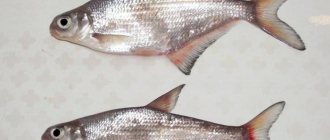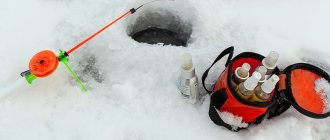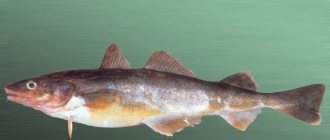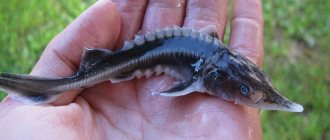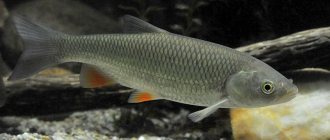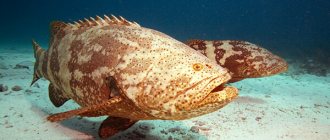Barbel
- the fish is quite large in size, it can grow up to 1 meter and gain a weight of 12 kg. In fact, many people dream of catching her. She is of serious sporting interest, as she has a strong body. It should be noted that all barbels are dexterous and smart. They won’t just get hooked, even if the bait is one of their favorite delicacies. The entire genus of fish of the Karpov family differs from the barbel. It is often confused with a gudgeon, but upon closer examination it can still be identified. All thanks to the antennae that are located on the cheeks of this representative. Obviously, it was thanks to them that it got its name.
Appearance
The barbel can be easily recognized by its torpedo-shaped body and unusual pink fins. The only fish that is similar to the barbel is the gudgeon, but it is significantly inferior to the barbel in weight and size. A distinctive feature of the barbel is two pairs of whiskers at the corners of the mouth and head. The gudgeon has whiskers located only in the corners of the mouth, and the gudgeon also has a duller speckled color. The color of the back varies from dark to olive green, the belly is whitish. The lateral line is well defined. The peculiar mustache of this fish serves to search for food at the bottom of the river, which the barbel then sucks into its mouth using a special device. The thick lips of the barbel serve as protection against damage from sharp gravel and snags on the river bottom. The eyes of the barbel are unusually small, although this is not typical for fish that are accustomed to finding food at the bottom in low light. But this suggests that the longhorned beetle relies more on its sensitive whiskers than on its eyesight when searching for food. It reaches a weight of more than 10 kg and a length of over 80 cm, but rarely, mainly fishermen come across specimens of much smaller sizes. Lives up to 20 years.
Species diversity and ranges
In the world of ichthyologists, questions about the classification of longhorned beetles still remain open. There are several species of these fish in Europe, but some researchers believe that there is actually one species, and all other species are its subspecies. The features of various barbels are discussed below.
Ordinary
Mainly inhabits Central and Western Europe, as well as Great Britain. Maximum dimensions – up to 75 cm in length with a weight of up to 9 kg. The color is slightly greenish or olive (upper body).
Among all the longhorned beetles, the common one has the largest scales.
The lower fins (pectoral, pelvic and anal) are slightly reddish in color. The dorsal and tail are grayish.
Polish
It is distinguished by its elongated body and relatively small size (up to 60 cm in length and weighing no more than 6 kg). Inhabits the Vistula and Oder basins.
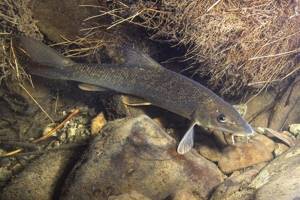
The fins of the Polish barbel are quite large, colored gray-yellow.
The coloring of this variety is often heterogeneous. There are individuals with a large number of dark scales, which is why the Polish barbel is also called speckled.
Types of barbel
Common barbel
This fish has many names, the main one being myron. In Belarus it is known as marona, on the Dnieper - miron and madder, on the Neman - kelb, etc.; small males are sometimes called tap dancers. The barbel is a large and fast-growing fish that prefers solitude. It gathers in large or small schools during spawning and in winter stops. It reaches a weight of more than 10 kg and a length of over 80 cm, but rarely, mainly fishermen come across specimens of much smaller sizes. Lives up to 20 years. The color of the back varies from dark to olive green, the belly is whitish. The lateral line is well defined. Sexual maturity occurs in the 3-5th year of life. Females are usually larger than males, but mature later than them. The barbel spawns in May - June, laying eggs in portions on sandy and pebble soil. Fertility is from 15 to 45 thousand eggs. Longhorn caviar is considered poisonous to humans. The barbel feeds mainly at dawn and at night on worms, mollusks, and insect larvae. A special delicacy for barbels is fish roe, which they eat in large quantities, thereby harming other species. Prefers rivers with fast currents and a sandy-pebble-rocky bottom. During the winter it lies in holes and holes under steep river banks and hardly feeds.
Aral barbel
This species is distinguished by the largest specimens, if we talk about all types of longhorned beetles found in the CIS. It leads an anadromous lifestyle, but also forms residential forms, in particular, it is found in the Syr Darya and Amu Darya rivers. Reaches a length of 1 meter and a weight of 20 kg. Compared to other species, the Aral barbel has denticles along the posterior edge of the thickened ray of the dorsal fin that are poorly visible. Having reached sexual maturity (5-6 years), it begins to move from feeding areas (from the open parts of the Aral Sea) along the western and eastern shores against streams of fresh water flowing in from the Amu Darya and Syr Darya. Individuals migrate that have reached high fatness and fat content, but with still immature reproductive products. The movement at sea towards the mouths reaches its maximum in June - July; Fish enter the rivers from June to August, rising many hundreds of kilometers.
During migration in the river, the Aral barbel almost does not feed and quickly begins to lose weight. Having entered the river for spawning, it prefers to spend the winter in holes with a medium current; in the spring, after the ice melts, it again rises slightly higher upstream to the spawning grounds. Before spawning, it feeds on scraps of plants and aquatic invertebrates, but sometimes does not disdain mice and lizards that have fallen from the shore into the water. Spawning areas extend almost throughout the flat course of the Syr Darya and Amu Darya. Spawning time is very extended - from the beginning of May to the end of July. Fertility is 190-560 thousand eggs. The eggs are spawned on rocky soil, and then rise into the water column and develop there.
After spawning, emaciated individuals roll downstream, go out to sea and begin to feed intensively. The main food in the sea is bivalves. It does not spawn every year, but, apparently, every year or two. After hatching, the juveniles stay in the river bed and actively feed on small bottom and benthic invertebrates. Most of the fry migrate to the sea in the autumn of the first year, but some individuals remain in the river for a much longer period and, apparently, some males reach sexual maturity in the river.
The barbel-chanari differs from the Aral barbel in having larger scales and a golden color. Very beautiful fish. Lives in the southern and western parts of the Caspian Sea. This species is larger than the Aral one and reaches up to 120 cm and weighs up to 9 kg.
Sevan longhorned beetle
A relatively short form, its representatives reach only 30 cm and 300 g. It also forms a residential form. It spawns both in the lake and in the rivers flowing into it. In Sevan it adheres to coastal zones. It feeds on mosquito larvae, amphipods, and fish eggs. The Crimean barbel is common in the rivers of the Western Caucasus and Crimea, the Dagestan barbel is common in the rivers of Dagestan, Kuma and Terek, and the Kura barbel is common in the Kura. These are all just subspecies of longhorned beetles that entered these reservoirs a long time ago.
Nutritional value of barbel meat
The composition of chemical elements and the nutritional value of meat depend on the age, gender and habitat of the individual. Fish proteins are highly digestible because they do not contain a large amount of connective tissue.
Fats consist of unsaturated fatty acids and have a digestibility of up to 98%. Fish oil contains many valuable biologically active substances:
- vitamin A;
- vitamin D;
- phosphatides;
- linoleic and arachidonic acids.
Madder liver contains many vitamins A and D, and meat contains B vitamins, as well as E, H, K, PP, etc. Minerals in fish meat are represented in small quantities, but have a rich composition. There are 50–75 times more microelements in fish meat than in products of animal origin.
The meat of this fish contains a lot of chromium and phosphorus. Chromium regulates blood glucose levels and enhances the action of insulin (a deficiency of this element leads to diabetes).
Phosphorus is involved in energy metabolism and acid-base balance. It is found in phospholipids, nucleotides and nucleic acids. Phosphorus compounds serve to mineralize teeth and bones (its deficiency leads to rickets, anorexia and anemia).
Nutritional value of 100 g of barbel meat:
- proteins - 20 g;
- fats - 6 g;
- ash - 1 g;
- calorie content - 135 kJ.
Macronutrients:
- phosphorus - 200 mg;
- sulfur - 200 mg;
- chlorine - 165 mg.
Microelements:
- fluorine - 435 mcg;
- chromium - 60 mcg;
- nickel - 5 mcg;
- molybdenum - 3 mcg;
- zinc - 0.6 mg.
Distribution area
Barbel fish is very common in Russia; photos of fishing enthusiasts with the long-awaited trophy often decorate thematic websites. But the habitat is not oriented to the entire country. In cold regions, the longhorned beetle is extremely rare, if not completely absent. This is due to the fact that at sub-zero water temperatures it simply will not be able to feed. It is difficult for him to get food where its availability is minimal.
Also, the fish in question can be found virtually throughout Europe. The exceptions are England and northern Scandinavia. Also, the longhorned beetle is not found in southern Italy. This is again due to cold climatic conditions or the lack of suitable bodies of water.
https://youtu.be/ttd9U2b3G0U
Habitats
Barbel fish
Many fish that are part of the Carp family live mostly in rivers. But sometimes they can be found in lakes or creeks. Such conditions allow only a few representatives to feed. Therefore, if a fisherman is lucky enough to catch a barbel in the lake, it will be incredibly large. For a short period of time, the population of this fish decreased noticeably. The reason for this was too polluted rivers and the pursuit of trophies. But now the population is gradually recovering. Today you can catch such fish in narrow rivers with an uneven bottom.
If you can find a barbel in a body of water other than a river, it is only because he was too carried away by the journey while searching for food. If there is no current, then the fish will not be able to reproduce, since there are no conditions for this. However, in quiet creeks and reservoirs there is a lot of food, so the largest trophies are found there. Needless to say, it will be easier to catch barbel in the river? The favorite place for fish is the bottom of the reservoir at a depth of 5-6 meters, which is necessarily covered with pebbles or coarse sand. In this case, the barbel will feed easily and have all the conditions for spawning.
Barbel is a fish whose menu is very diverse. But this is not at all the result of an abundance of favorite delicacies. Since longhorned beetles feed on whatever they find on the river bottom, a large menu is driven by the diversity of organic life. Most often, this fish, part of the Karpov family, eats the eggs of other river inhabitants, as well as larvae. But sometimes she comes across small mollusks, which also make up her diet. Longhorned beetles will refuse food only if it does not fit into their mouth.
This fish does not disdain various waste. If the remains of animals after a slaughterhouse are thrown into the river, then the longhorned beetles will live happily in it. Often fish eat crustaceans or algae, but not all of them, but only those that suit their taste. Smaller river inhabitants can also become prey for barbel. In short, he will eat whatever he finds at the bottom, even if it is small fish or waste from a slaughterhouse.
Lifestyle
The barbel is a fish that only occasionally prefers company. She usually leads a solitary life. But she has to step over her principles during the winter stay and spawning period. Then the barbels gather in schools. The fish feed is focused on late at night. Sometimes she continues to swim in search of food in the early morning. In addition, the barbel may go out hunting during the day in the fall or spring, when the temperature at night is too low.
For the winter, all the fish in question hide in burrows or depressions, since the water in them is warmer. At this time they have almost nothing to eat, so they do not waste energy on this process and actually do not come out of hiding. There is no predisposition to migration in fish. She will only swim across in search of a new home if her river is too polluted. During the daytime, barbels descend to the bottom. In addition, the larger the fish, the greater the depth it will need in order to feel normal. It reaches its greatest activity in the pre-dawn hours, and then you need to catch it.
Reproduction
Females are usually larger than males, but mature later than them. The barbel spawns in May - June, laying eggs in portions on sandy and pebble soil. Fertility is from 15 to 45 thousand eggs. Longhorn caviar is considered poisonous to humans. Males mature at 2-3 years with a length of 15-16 cm, females at 3-4 years with a length of no more than 22 cm. Spawning occurs at a water temperature of 11 -15 ° on rocky or pebble soil in late May - June in the southern regions and in June - early July - in the northern ones. Spawning is gregarious. Life expectancy is up to 12-13 years.
Cooking recipes
This fish can be baked, fried, boiled fish soup and stewed using various vegetables and spices.
Baked barbel
For baking you will need:
- fish - 1 kg;
- onion - 2 pcs.;
- tomatoes - 3 pcs.;
- greens (dill, parsley) - 1 bunch;
- lemon - 1 pc.;
- vegetable oil - 4 tbsp. l.;
- bay leaf - 3−4 pcs.;
- ground black pepper;
- salt (to taste).
Cooking process:
- Gutted and washed fish are peppered, salted and placed in a greased form.
- Washed tomatoes are cut into circles.
- Peeled onions are thinly cut into rings.
- The greens are washed and coarsely chopped.
- Lemon is cut into circles, having previously been doused with boiling water.
- All ingredients are mixed and distributed inside the fish and on its surface.
- Cover the prepared dish with foil or parchment paper.
- The form with the fish is placed in the oven, preheated to +120°C.
- After 30 minutes, remove the foil or paper and continue baking at a temperature of +225°C for 5 minutes.
- The fish is served on the table in the same form.
Fried barbel with gherkins and mushrooms
For this recipe you need the following products:
- fish - 1 kg;
- onion - 2 pcs.;
- fresh mushrooms - 200 g;
- gherkins - 150 g;
- vegetable oil - 5 tbsp. l.;
- ground black pepper;
- salt.
This dish is prepared like this:
- Filled fish is cut into portions.
- Pieces of barbel are rolled in flour and fried on both sides.
- Mushrooms are washed, finely chopped and stewed.
- Separately, fry onion cut into half rings.
- Add mushrooms and finely chopped gherkins to the fried onions, and pour this mixture over the fried fish.
- The dish is simmered over low heat for another 5 minutes.
Fishing Features
Fishing begins with the complete fall of flowers in the gardens.
They fish with a reel, a bottom line, a bottom fishing rod, and occasionally with a spinning rod and a float rod. The most successful fishing is with bottom wiring and wiring. Bottom fishing is classic in its techniques and does not require a description. It is better to fish in a retrieve with a long release of the float, for which you need to equip a powerful and rigid fishing rod with guide rings and a reel. A small spinning reel with an easy stroke is more suitable, so that the current freely carries the float, winding the line from the reel with slack between the float and the tip of the rod. Lines with a diameter of 0.45 mm with a leash of 0.3–0.35 mm. The line should not be painted, but the leash can be painted light blue. The float is spindle-shaped, somewhat larger than usual for sinkers made of small buckshot or three pellets. For better visibility, it is surrounded only by 2/3 of the length. Straight hooks No. 8–12, which depends on the size of the bait and the weight of the fish expected in the catches. Catching barbel
The best baits are a spindle and a crawler. Earthworms, omentum, bivalve shells, crayfish and its neck, maggot and soft unsalted cheese are also used. To swim the bait in places with different depths and uneven bottoms, you have to control the gear, which is sometimes tiring and makes it difficult to distinguish bites. Shallow places pass, holding the float and causing the bait with sinkers to rise. At the beginning of the retrieve, sometimes you have to feed the line from the reel by hand until the float pulls it on its own. Bait is rarely used; it usually has no effect, often attracting other fish. The barbel hook, even at a long distance to the float, should be sweeping, but not sharp. The hook fits easily into its fleshy mouth.
After hooking, the barbel often rushes against the current, pulls very stubbornly and strongly, pressing against the bottom, often stops, stands up straight, with its head in the bottom. Both of these techniques can result in dead holds. You need to have time to wind the line onto the reel without allowing it to loosen. Sometimes, with a strong pull, you have to follow the barbel along the shore. Having overcome the first jerk, you must always be ready for a new throw in order to give up the line in time or run after it along the shore. The barbel does not allow itself to be taken out immediately; its resistance is stubborn and long-lasting. In the event of a snag, there is no need to despair; often the barbel frees itself from it; the line should be kept taut and, as soon as it sets off, continue fishing.
Barbel is caught with bottom fishing rods on an uncluttered, clean bottom, usually in the furrows of the fairway, which are quite close to the banks, on a pebble and coarse sand bottom. Lines with a diameter of 0.6 mm with a leash of 0.5 mm, painted sandy color. The leash is connected via a carabiner. The sinker is heavy, weighing up to 150 g, often sliding, but sometimes also an end one, connected to the line through a carabiner. Hook No. 9–12 with a long shank and a bent sting. Animal baits firmly attached to hooks are used as bait. The best one is the spindle. In very fast currents, the line is replaced with steel wire with a diameter of 0.2 mm, which makes it easier for the sinker to stay on the bottom and significantly reduces the number of snags on rocks. The wire is handled carefully, avoiding kinks and “wings”. The bottom line is attached to the tip of a rigid fishing rod and the alarm is closely monitored. When casting long distances, it is necessary to hook the fish; in these cases, self-hooking is a rare occurrence. With a float rod, barbel is caught in the same way as carp and carp - from the bottom and plumb.
How to catch
Myron can be caught with different tackles. In general, predicting the behavior and intensity of the bite is quite problematic, so it is recommended to use another if one gear is ineffective.
Float rods
For barbel fishing, choose a rod with a length of more than 5 m. Since the fishing location will be on the current, it is best to do it in a retrieve. To do this, choose an inertia-free reel with a fishing line up to 50 m long and at least 0.35 mm thick. Leads – 0.25-0.3 mm.
Myron bites near the bottom level, so the load should deliver the bait as close to it as possible. The sinker in this case is attached to the end of the fishing line. The leashes are located slightly higher. That is, the sinker practically drags along the bottom under the influence of the current.
Bottom fishing rod
One of the most popular gear for catching barbel. Most often, equipment with a blind or sliding sinker is used; feeder equipment with a feeder is also used. The main line is monofilament with a diameter of 0.4 mm, the leads are the same as in the case of a float rod. The optimal hook size is No. 6 or No. 7.
Important! All connections of the equipment are made using swivels and latches.

